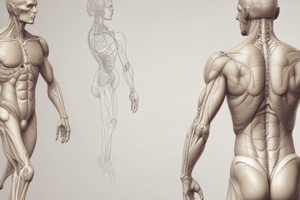Podcast
Questions and Answers
A tool for evaluating movement patterns and spotting any restrictions or asymmetries in a person's mobility
A tool for evaluating movement patterns and spotting any restrictions or asymmetries in a person's mobility
Functional Movement Screen
The FMS was developed by physical therapists _____ and is widely used in the fields
of sports medicine, physical therapy, and fitness training.
The FMS was developed by physical therapists _____ and is widely used in the fields of sports medicine, physical therapy, and fitness training.
Gray Cook and Lee Burton
It comprises of SEVEN FUNDAMENTAL MOVEMENT ASSESSMENTS that
assess coordination, strength, and flexibility.
It comprises of SEVEN FUNDAMENTAL MOVEMENT ASSESSMENTS that assess coordination, strength, and flexibility.
Functional Movement Screen
BENEFITS OF FMS
BENEFITS OF FMS
The Seven (7) Movement Patterns
The Seven (7) Movement Patterns
The dowel overhead requires bilateral symmetrical mobility and stability of the shoulders, scapular region, and the thoracic spine.
The pelvis and core must establish stability and control throughout the entire movement to achieve the full pattern.
The dowel overhead requires bilateral symmetrical mobility and stability of the shoulders, scapular region, and the thoracic spine. The pelvis and core must establish stability and control throughout the entire movement to achieve the full pattern.
is an integral part of locomotion and acceleration.
is an integral part of locomotion and acceleration.
This movement challenges the
body’s step and stride mechanics, while testing stability and control in a single leg stance.
This movement challenges the body’s step and stride mechanics, while testing stability and control in a single leg stance.
places the body in a position to simulate stresses during rotation, deceleration and lateral movements.
places the body in a position to simulate stresses during rotation, deceleration and lateral movements.
demonstrates the natural complementary rhythm of the scapular-thoracic region, thoracic spine and rib cage during reciprocal upper-extremity shoulder movements.
demonstrates the natural complementary rhythm of the scapular-thoracic region, thoracic spine and rib cage during reciprocal upper-extremity shoulder movements.
Flashcards
Functional Movement Screen (FMS)
Functional Movement Screen (FMS)
A tool used by physical therapists and others to evaluate movement patterns, looking for restrictions and imbalances.
FMS Developers
FMS Developers
Gray Cook and Lee Burton developed the FMS.
FMS Assessments
FMS Assessments
The FMS uses 7 fundamental movement tests to evaluate coordination, strength, and flexibility.
Deep Squat
Deep Squat
Signup and view all the flashcards
Hurdle Step
Hurdle Step
Signup and view all the flashcards
Inline Lunge
Inline Lunge
Signup and view all the flashcards
Shoulder Mobility
Shoulder Mobility
Signup and view all the flashcards
Active Straight-Leg Raise
Active Straight-Leg Raise
Signup and view all the flashcards
Trunk Stability Push-Up
Trunk Stability Push-Up
Signup and view all the flashcards
Rotary Stability
Rotary Stability
Signup and view all the flashcards


